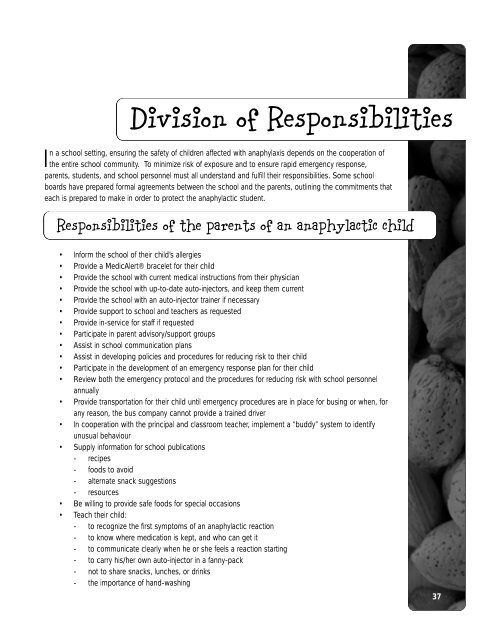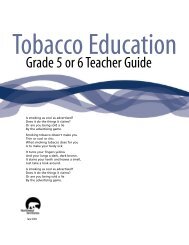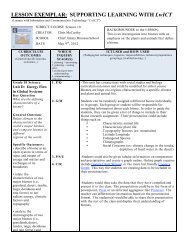Anaphylaxis: A Handbook for School Boards - Education, Culture ...
Anaphylaxis: A Handbook for School Boards - Education, Culture ...
Anaphylaxis: A Handbook for School Boards - Education, Culture ...
Create successful ePaper yourself
Turn your PDF publications into a flip-book with our unique Google optimized e-Paper software.
Division of ResponsibilitiesIn a school setting, ensuring the safety of children affected with anaphylaxis depends on the cooperation ofthe entire school community. To minimize risk of exposure and to ensure rapid emergency response,parents, students, and school personnel must all understand and fulfill their responsibilities. Some schoolboards have prepared <strong>for</strong>mal agreements between the school and the parents, outlining the commitments thateach is prepared to make in order to protect the anaphylactic student.Responsibilities of the parents of an anaphylactic child• In<strong>for</strong>m the school of their child’s allergies• Provide a MedicAlert® bracelet <strong>for</strong> their child• Provide the school with current medical instructions from their physician• Provide the school with up-to-date auto-injectors, and keep them current• Provide the school with an auto-injector trainer if necessary• Provide support to school and teachers as requested• Provide in-service <strong>for</strong> staff if requested• Participate in parent advisory/support groups• Assist in school communication plans• Assist in developing policies and procedures <strong>for</strong> reducing risk to their child• Participate in the development of an emergency response plan <strong>for</strong> their child• Review both the emergency protocol and the procedures <strong>for</strong> reducing risk with school personnelannually• Provide transportation <strong>for</strong> their child until emergency procedures are in place <strong>for</strong> busing or when, <strong>for</strong>any reason, the bus company cannot provide a trained driver• In cooperation with the principal and classroom teacher, implement a “buddy” system to identifyunusual behaviour• Supply in<strong>for</strong>mation <strong>for</strong> school publications- recipes- foods to avoid- alternate snack suggestions- resources• Be willing to provide safe foods <strong>for</strong> special occasions• Teach their child:- to recognize the first symptoms of an anaphylactic reaction- to know where medication is kept, and who can get it- to communicate clearly when he or she feels a reaction starting- to carry his/her own auto-injector in a fanny-pack- not to share snacks, lunches, or drinks- the importance of hand-washing37
















